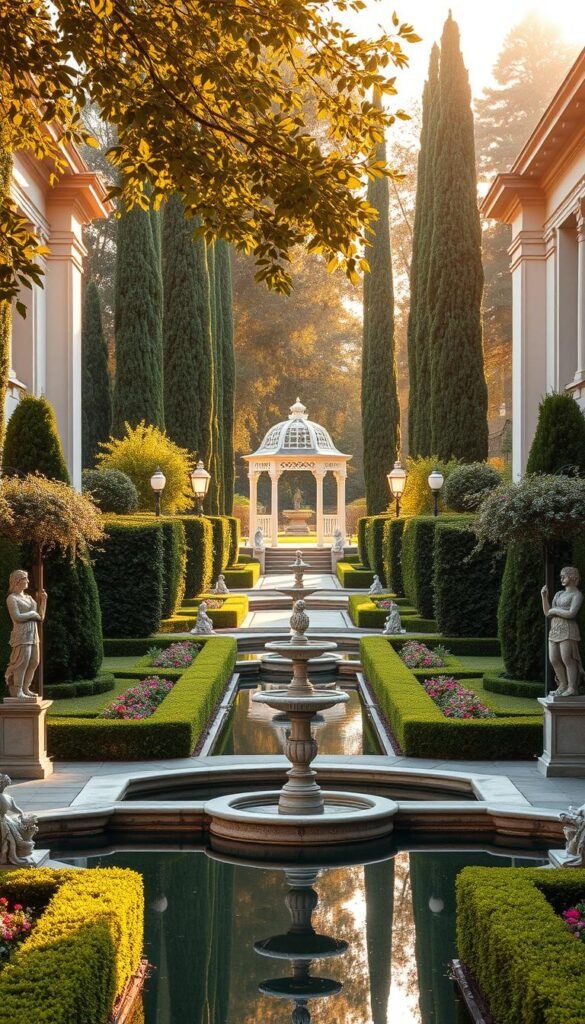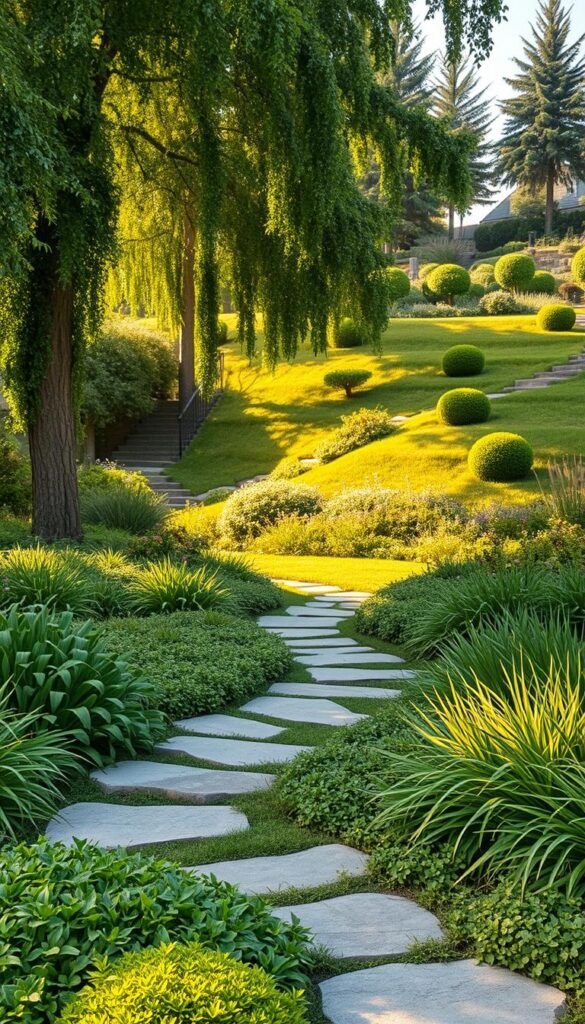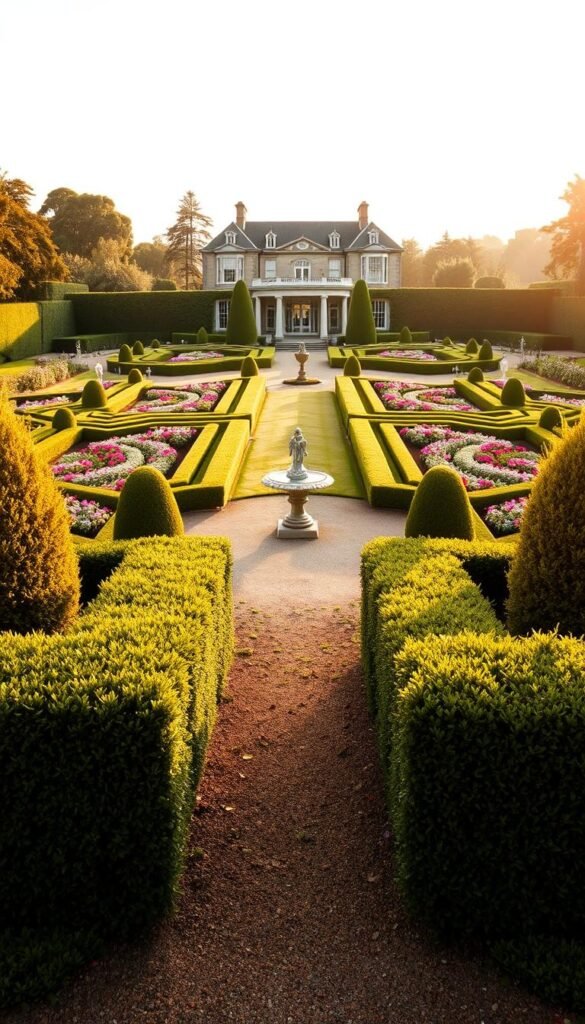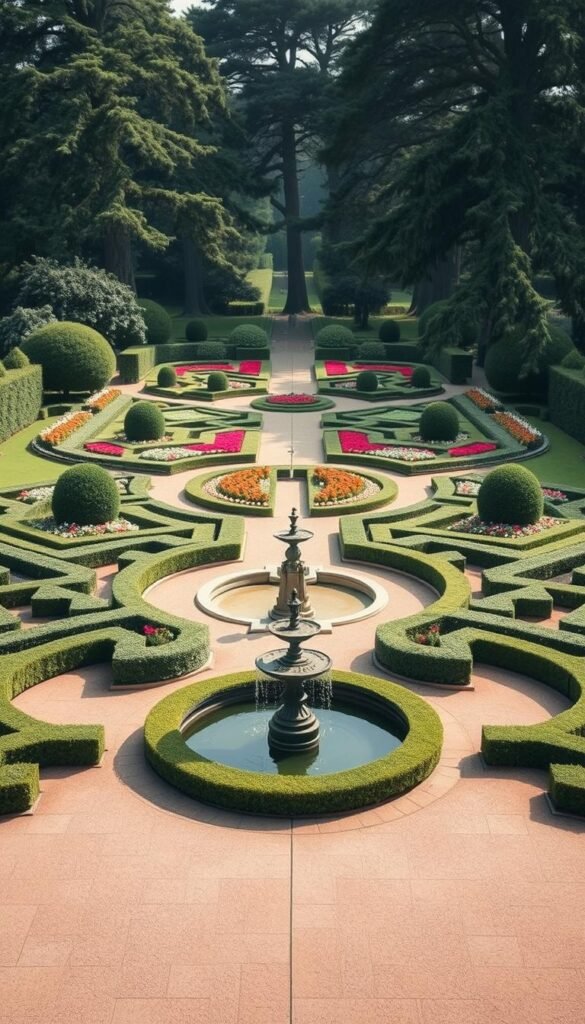Creating a stunning outdoor space starts with understanding how balance shapes beauty. Whether drawn to crisp geometric patterns or flowing natural arrangements, your landscape can become a true extension of your personality. Strategic use of lines and shapes unlocks endless possibilities, letting you craft spaces that feel both intentional and inviting.
You might love the crisp order of mirrored layouts or the relaxed energy of uneven compositions. Both approaches create visual harmony when executed thoughtfully. Recent surveys show 67% of homeowners find professional guidance helps achieve better results, but knowing core principles empowers you to collaborate effectively or tackle projects solo.
Great spaces aren’t about strict rules—they’re about purposeful choices. Placement of plants, pathways, and focal points determines whether your yard feels calming or dynamic. Even small tweaks, like offsetting a statue or repeating shrubs, can transform ordinary areas into eye-catching retreats.
Your preferences matter most. Do you crave formal elegance or casual charm? By blending structured elements with organic touches, you create outdoor rooms that suit your lifestyle. Maintenance needs, seasonal changes, and functional goals all shape these decisions, ensuring your design works as hard as it impresses.
Understanding the Foundations of Symmetry in Garden Design

The secret to a polished landscape lies in deliberate arrangement techniques. Symmetrical layouts create mirror-image patterns around a central axis, like your front door or fountain. This approach brings instant curb appeal while making spaces feel organized and welcoming.
Defining Symmetry and Its Principles
Visual balance anchors symmetrical designs. Imagine matching shrubs flanking a walkway or identical planters on either side of stairs. These mirrored elements create harmony through repetition. Designers often use geometric shapes – squares, circles, rectangles – to reinforce this structured effect.
Historical Context and Modern Applications
Formal European estates popularized symmetrical gardens centuries ago. Today, homeowners adapt these principles for modern yards. Front entries remain prime spots for mirror-image layouts, though some blend symmetry with creative twists.
Consider these factors when planning:
| Feature | Symmetrical Design | Asymmetrical Design |
|---|---|---|
| Visual Impact | Formal, structured | Relaxed, natural |
| Maintenance | High (regular trimming) | Moderate |
| Best For | Traditional homes | Sloped or irregular lots |
While symmetrical layouts excel at creating order, they demand commitment. Plants must stay perfectly trimmed, and hardscapes need precise alignment. For those wanting structured beauty without strict mirroring, symmetrical vs asymmetrical landscape design comparisons reveal smart hybrid approaches.
Embracing Asymmetry for an Organic Outdoor Space

Nature rarely follows straight lines, and your garden doesn’t have to either. Asymmetrical layouts let you craft spaces that feel alive and dynamic while maintaining visual harmony. Think of it as organized freedom—a design approach where balance comes from thoughtful contrasts rather than mirror images.
Key Characteristics and Natural Variations
Start by choosing a focal point—a sculptural tree, bubbling fountain, or even an empty spot where energy converges. Balance different elements by weight, not quantity. For instance, pair a towering hydrangea with a cluster of lavender bushes. Their combined visual mass creates equilibrium without matching shapes.
Curved pathways and irregular plant groupings work wonders here. Mix textures like feathery grasses beside glossy camellias to add depth. This “intentional spontaneity” lets your garden space feel casually elegant rather than chaotic. Bonus? Overgrown edges look purposeful, not messy.
Inspiring Design Ideas from Real-Life Examples
Take cues from Longwood Gardens’ famous conservatory beds. They balance five varying-height plants on one side with a single statement specimen elsewhere. Up close, the arrangement feels wild—step back, and everything clicks into place.
Backyard patios thrive with this approach too. Offset a fire pit with staggered seating areas or blend edible plants into ornamental beds for functional beauty. Remember: asymmetry isn’t random. Repeat colors or leaf shapes to tie the design together while letting nature’s quirks shine.
The Role of Symmetry and Asymmetry in Formal Garden Design: Practical Tips for Your Garden

Transform your outdoor space into a balanced retreat using smart landscaping strategies. Start by marking your central feature—a striking tree, water feature, or architectural element. This anchor point guides placement of other elements while creating natural flow.
Smart Layout Planning
Flank walkways with contrasting plant heights for instant harmony. Try tall ornamental grasses on one side paired with creeping thyme on the other. For slopes, position boulders strategically to counterbalance vertical elements like slender trees.
Plant Selection Secrets
Choose species that complement your climate and design goals. Palm varieties thrive in containers, while hydrangeas add lush texture. Mix reliable performers like begonias with bold tropicals—black anthuriums make stunning focal points without overwhelming beds.
| Feature | Symmetrical Approach | Asymmetrical Solution | Hybrid Option |
|---|---|---|---|
| Plant Types | Identical shrubs | Mixed heights/textures | Mirrored colors, varied forms |
| Maintenance | Weekly trimming | Seasonal pruning | Biweekly adjustments |
| Visual Effect | Formal elegance | Natural charm | Structured spontaneity |
Mastering Visual Weight
Offset large shade trees with clustered perennials in complementary colors. At entries, balance chunky planters with airy grasses. Remember: three small flowering bushes often equal one statement shrub in visual impact. Test arrangements by squinting—balanced compositions feel calm, not chaotic.
Your garden design should evolve with your needs. Track how sunlight shifts across beds and adjust plant placements annually. With these techniques, you’ll create spaces that feel intentionally crafted yet effortlessly inviting.
Bringing Your Garden Vision to Life
Your dream outdoor space becomes reality when vision meets thoughtful preparation. Like professional horticulturists planning seasonal displays a year ahead, your garden design thrives with detailed forethought. Consider how colors shift from spring blooms to autumn foliage, and how textures interact as plants mature.
Balance remains key—whether through mirrored layouts or intentional contrasts. Pair sculptural trees with delicate ground cover, or let asymmetrical plant groupings guide the eye. Successful landscaping blends form and function, creating spaces that feel both curated and effortless.
Map your beds considering sunlight patterns and growth habits. Will that hydrangea outgrow its spot? Does the Japanese maple cast summer shade where needed? Adapt plans as your space evolves, just as gardens change through seasons.
Remember: great designs aren’t rushed. Sketch layouts, test arrangements with potted specimens, and refine over weeks. Your patience pays in cohesive beauty that delights year-round—proof that every intentional choice cultivates harmony.






